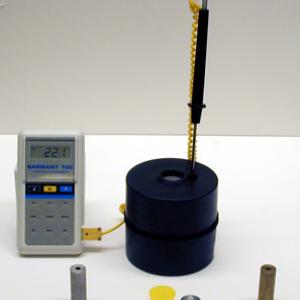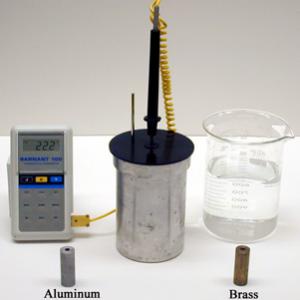College of Liberal Arts & Sciences
4B10.26 - Specific Heat App. - Calorimeter
Heat the specimens in boiling water for at least ten minutes then put them in the calorimeter and measure the change in temperature. Picture 1 is of a dry calorimeter. Just heat the metal specimens and insert into the hole in the calorimeter and observe the temperature rise after several minutes.
The same size samples of Al, Cu, Fe, Mg, Zn, and Pb are available.
Picture 2 is a calorimeter that a measured amount of water is added to which acts as the heat sink. The temperature rise of this measured amount of water is then observed for several minutes.
- John Koser, "Laboratory Activity: Specific Heat by Change in Internal Energy of Silly Putty", TPT, Vol. 49, #9, Dec. 2011, p. 574.
- C. R. Mattos and A. Gaspar, "Introducing Specific Heat Through Cooling Curves", TPT, Vol. 40, #7, Oct. 2002, p. 415.
- Philip Gash, "So You Thought a Glass Thermometer Measured Temperature", TPT, Vol. 40, #2, Feb. 2002, p. 74.
- Colin Terry, "Specific Heats–Direct, Quick, and Simple", TPT, Vol. 36, #4, Apr. 1998, p. 214.
- James L. Hunt and Tracy L. Tegart, "Measuring the Heats of Water", TPT, Vol. 32, #9, Dec. 1994, p. 545.
- William L. Kerr and David S. Reid, "Thermodynamics and Frozen Foods", TPT, Vol. 31, #1, Jan. 1993, p. 52.
- Mario Iona, "Calorimetry Calculations", TPT, Vol. 23, #7, Oct. 1987, p. 419.
- Albert A. Bartlett, "A Large Solar Calorimeter", TPT, Vol. 24, #8, Nov. 1986, p. 484.
- Albert A. Bartlett, "Calorimetry: The Center of Heat Capacity", TPT, Vol. 23, #5, May 1985, p. 302.
- Peter Lindenfeld, "Size Effects in Conductivity and Superconductivity (Apples, Wires, and Grains)", TPT, Vol. 18, #4, Apr. 1980, p. 260.
- Varghese D. Pynadath, "Insulation and Rate of Heat Transfer", TPT, Vol. 16, #6, Sept. 1978, p. 379.
- Ronald F. Gleeson, "A Sequel to the PSNS Specific Heat Experiment", TPT, Vol. 10, #7, Oct. 1972, p. 399.
- Francisco Glover, "Specific Heat Capacity — A Quantum Explanation", TPT, Vol. 9, #3, Mar. 1969, p. 149.
- John L. Roeder, "Activity 7: Energy From Chemical Fuels", Teaching About Energy, p. 95.
- David Kutliroff, "63. Make a Mechanical Analog for Comparing Specific Heat of Monatomic and Diatomic Gases", 101 Classroom Demonstrations and Experiments For Physics Teachers, p. 140.
- Robert Ehrlich, "I.1. Measuring Specific Heat by the Method of Mixtures", Turning the World Inside Out and 174 Other Simple Physics Demonstrations, p. 113 - 114.
- Yaakov Kraftmakher, "2.8. Principles of Modulation Calorimetry", Experiments and Demonstrations in Physics, ISBN 981-256-602-3, p. 124.
- Yaakov Kraftmakher, "2.7. Pulse Calorimetry", Experiments and Demonstrations in Physics, ISBN 981-256-602-3, p. 111.
Disclaimer: These demonstrations are provided only for illustrative use by persons affiliated with The University of Iowa and only under the direction of a trained instructor or physicist. The University of Iowa is not responsible for demonstrations performed by those using their own equipment or who choose to use this reference material for their own purpose. The demonstrations included here are within the public domain and can be found in materials contained in libraries, bookstores, and through electronic sources. Performing all or any portion of any of these demonstrations, with or without revisions not depicted here entails inherent risks. These risks include, without limitation, bodily injury (and possibly death), including risks to health that may be temporary or permanent and that may exacerbate a pre-existing medical condition; and property loss or damage. Anyone performing any part of these demonstrations, even with revisions, knowingly and voluntarily assumes all risks associated with them.

